Most of our tasks fall into one of the following categories...
Tree and scrub clearance

Heathland is a man-made, but ecologically valuable, habitat. The heaths of southern England were created on areas of soil too poor for crops, and historically were maintained by grazing, burning and collecting fuel wood. As an artificial habitat, open but not cultivated, heathland supports many unusual and specialist species.
With the loss of traditional management, and conversion to other uses, lowland heath is now scarce and declining (down to about 16% of its nineteenth-century extent). It is a priority habitat under the UK Biodiversity Action Plan. Without management, heathland is invaded by scrub, and (although it may host more species in total) widespread generalist species benefit while heathland specialists decline.
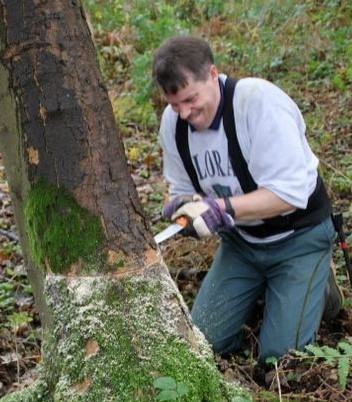
We clear invasive (mainly birch and gorse) and non-native (mainly sycamore, holm oak and Italian alder) trees and scrub to prevent the common turning into a wood. We also coppice hazel in the woods surrounding the central heathland plateau, to preserve a historic woodland management tradition and to enhance dormouse habitat.
Most of this work is done with hand tools (bowsaws, pruning saws, shears and loppers) but properly trained members and BBOWT staff also use chainsaws and brushcutters. Where appropriate, we treat the stumps with herbicide to prevent re-growth. Logs are stacked into habitat piles for amphibians, reptiles and insects, and we usually have a bonfire for the smaller brash.
Birch
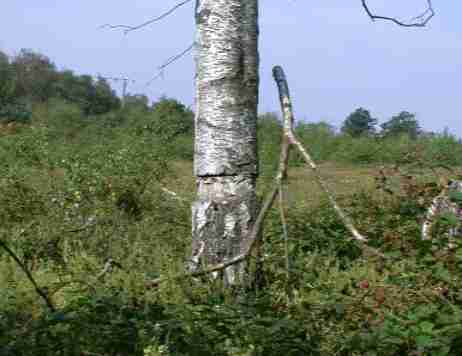
On Greenham and Crookham Commons we have silver birch (Betula pendula) and downy birch (Betula pubescens).
These are native throughout northwest Europe including the UK, and have very high wildlife value. The light canopy of small leaves casts dappled shade, allowing a varied ground flora of mosses, grasses and flowering plants which provide varied food for invertebrates, birds and mammals. In Britain silver birch supports 230 insect species (162 of which are strongly dependent on birch) and is specifically associated with several fungi. The insects, and the copious seeds, attract numerous birds.
But birch is natural pioneer, colonising bare ground with its small wind-blown seeds and thriving on nutrient-poor acid soils with the assistance of mycorrhizal fungi. Once established, a birch wood produces up to 4 tonnes of leaf litter per hectare annually, enriching the soil and facilitating further succession to oak and other longer-lived trees.
Birch is one of the major types of woodland around the edges of the commons, and there is no intention to remove it all! However, locally and nationally there is a lot of birch woodland, while lowland heath is much scarcer and shrinking in area. Some areas of birch, especially where they have recently invaded heathland areas and some heather is still present, are cleared by felling and stump treatment (with glyphosate or triclopyr) to prevent re-growth. Some large specimens are ring-barked to leave standing dead wood, a valuable invertebrate habitat.
Some birch is also cut commercially on the commons (not by the GCCV) for besoms and horse-racing hurdles. Some of our scrub control is actually aimed at maintaining traditional coppice areas, rather than to eradicate birch entirely.
Some locally important species, such as the nightjar, like a gradual transition between woodland and heath. Birch is therefore selectively felled to create scalloped edges to the woods, with scattered trees left as standards in cleared areas.
Italian alder
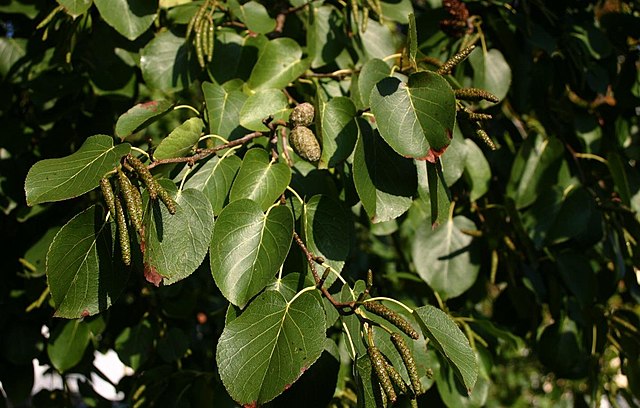
Alnus cordata was, apparently, planted on the airbase by the RAF's landscape contractor as part of mixed-species plantations. It is an exotic, originating from Corsica and southern Italy. It's also highly invasive: The seeds are tiny (about 2,000 to the level teaspoonful) and spread far and wide on the wind. It's a particular problem on nutrient-poor soils, which we have, because it is a nitrogen-fixer. It's also far more tolerant of drier soil conditions than our native alder A glutinosa. Alder trees have a heavy leaf canopy and autumn leaf fall rapidly increases the humus content of the soil. And worst of all, it seems to be quite resistant to herbicides, so there's always a possibility than any we cut will grow back again. When it does that it tends to produce a lot of low horizontal branches along the ground, which make it even more difficult to cut next time around.
Italian alder is a rather light-demanding tree, so it hasn't become dominant in the plantations where it was originally planted. But it now completely dominates what were open areas between the plantations. It's also having a good go at taking over areas including the control tower car park, the relandscaped Crookham Pools, and other parts of the commons which previously were sparsely vegetated.
One positive point is that cattle find Italian alder tasty, and browse the ends of the twigs. This means that specimens growing where they are accessible are unable to produce catkins (the male flowers) or the seed-bearing female cones. So low-growing trees out in the open are not the big problem. The ones we concentrate on are the tall ones, and the ones growing in dense thickets of bramble, rose and gorse. These don't get eaten, and so are the ones able to produce and spread seed.
Rhododendron
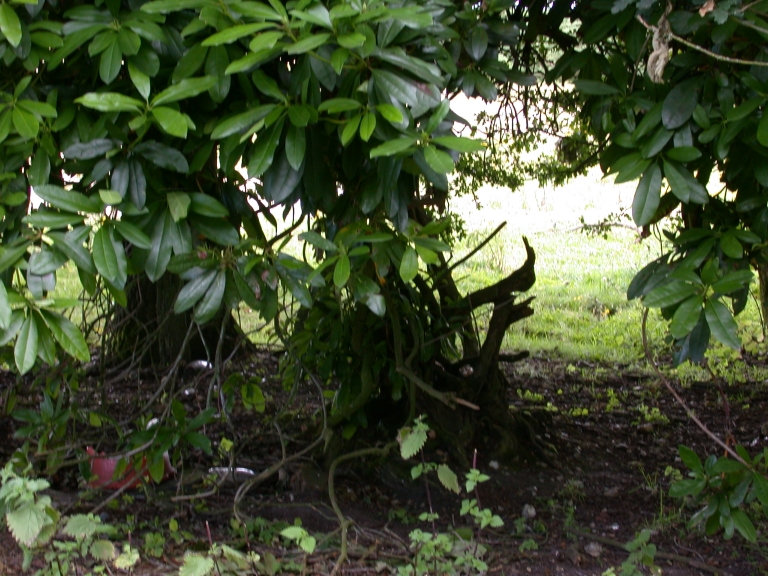
Rhododendron is a highly invasive exotic evergreen, threatening landscape character and biodiversity, and also an important host for Phytophthera ramorum, the fungus which causes "sudden oak death" disease. It is native to the Mediterranean and was introduced from Gibraltar in 1763. (It was present in Britain in previous interglacials but did not re-colonise after the last glacial period.)
Rhododendron spreads by layering and copious seed production (over 1m seeds per bush). It produces toxins, and suppresses other plants by poisoning the soil as well as year-round shading. Using the same mycorrhizal fungal associates as heather to maximise nutrient uptake from poor acidic soils, it is particularly invasive on heathland because suitable fungi are already present. In woodland, rhododendron prevents seedlings establishing, so when old trees die they are not replaced and the natural and highly biodiverse structure of ground layer, field layer, understorey and canopy disappears.
Few insects or other herbivores eat rhododendron, due to its toxicity. Most of the 31 British insects found on it are widespread generalists - only six introduced species are rhododendron specialists.
On the (comparatively minor) plus side, rhododendron provides dense cover (many historical introductions were for game cover on estates). Various warbler and thrush species feed and nest in rhododendron stands, and finches and thrushes favour it for winter roosting sites. It provides cover for deer, badger setts and fox earths. The abundant flowers are highly attractive to insects (but rhododendron honey can be poisonous!).
Rhododendron is the biggest threat on some heathland sites, but on Greenham Common invasions from adjoining properties are localized and have mostly been dealt with. However, it is best to tackle rhododendron before it becomes entrenched, because the toxic leaf litter can prevent re-establishment of native plants for years after a stand has been removed. So we check for re-growth in the cleared areas, and look out for isolated specimens. We don't burn the cuttings because even bonfire smoke from rhododendron is said to be toxic!
Sycamore
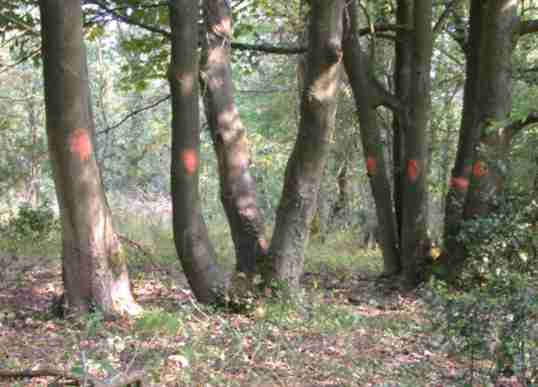
The real home of the sycamore is high ground in southeast Europe and the Caucasus. It is uncertain when it was introduced to Britain - It may have been brought by the Romans, but the first definite written record in England dates from 1578. Sycamore was still scarce here in the 16th century, and has only really become established in the last 200 years. This tree is very tough, being tolerant of salty coastal winds, and growing higher on hills than any native broadleaf tree except for rowan. It is also highly invasive, propagating from its copious winged seeds, and is still spreading vigorously throughout the UK. Sycamore is now more geographically widespread than any native tree except ash and hawthorn.
When sycamore invades birch, ash and other lightly-shading woodland, the extra shade beneath its large leaves suppresses the ground flora. Bird numbers also decline once the sycamore canopy closes. Sycamore supports only 19 insect species despite its long history in Britain, compared to 423 recorded on oaks and 450 on willows. However, it supports similar numbers of lichens to native trees, and its flowers provide springtime food for bees. Wood mice will eat the fallen seeds, but only if acorns and beech nuts are scarce. The relatively unpalatable seeds may be one reason why sycamore is such a successful coloniser. It also supports very high aphid populations, an important food source for birds.
Sycamore seedlings don't establish well in established grassland, but readily colonise bare soils and existing woodland - a problem in the woods around the edges of the commons, and in the bare areas where roads and runways have been removed. Sycamore is controlled by felling and stump treatment, but some large specimens are left because of their potential for nest sites.
Interesting fact:
Sycamore wood is very hard and was used in prehistory for spear points. “Acer” is latin for sharp !
Buddleia
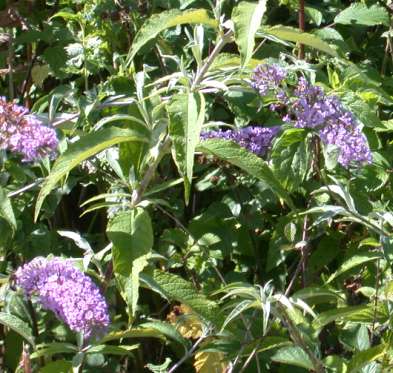
Originally from China, buddleia was introduced to Britain as a garden plant about 1890. Its copious nectar production famously attracts butterflies - more than any native plant species! Some conservation organisations encourage (or used to, before realising its invasive nature) people to plant buddleia to attract butterflies to wildlife gardens. However, while providing nectar for the adults, it provides no food for the leaf-eating caterpillars of most species.
Buddleia is also highly invasive and a threat to native plant diversity. Producing 3 million small wind-blown seeds from a single bush, it colonises bare and disturbed ground especially well, and thrives in dry stony soils with low humus content. Once established buddleia can quickly form dense monospecific stands. While buddleia may actually be a useful wildlife resource on urban waste ground, railway yards etc. which would otherwise be barren, on heathland it is an unwelcome competitor with native plants.
We have some areas in which buddleia is spreading, (particularly near the boundaries where it seeds in from adjoining properties) and some individuals scattered over the plateau which might be the beginnings of dense colonies. The bare gravel areas from which runways and roads have been removed are favourable sites for colonisation. The main concern is that buddleia will invade these areas before more desirable heathland species such as heather become established.
Clearing other unwanted plants
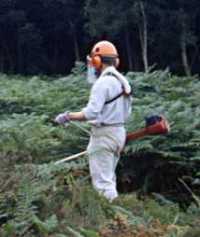
Globally, invasive introduced species are the second greatest threat (after habitat destruction) to biodiversity. We attempt to control ragwort (poisonous to grazing livestock) and bracken (overshades and outcompetes heather). That's a never-ending battle, but we also hope (and are on course) to completely eradicate Himalayan balsam from the commons. We have also cleared most of the rhododendron, although it was never such a widespread problem here as it is on many heathland sites.
One of the most obvious invasive alien species now on the commons is the Crassula helmsii which forms a thick carpet around many of the ponds. Unfortunately, there's not much we can do about it.
Bracken
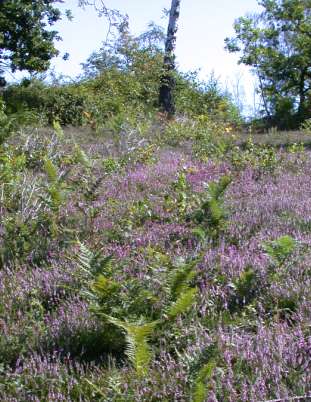
Bracken is native throughout the temperate & tropical zones, including the UK. It has some limited value to certain insects and birds, but is highly invasive on acid soils. Originally in the UK a woodland plant, it was kept in check by shading. In historic times, as trees were cleared for agriculture, it was controlled by grazing and cutting for various uses (winter bedding, fodder, thatch, and also glass & soap making due to the high potash content of bracken ash). But following the withdrawal of traditional management from large areas of open countryside, bracken has become highly invasive, and now covers 4% of the UK.
If confined to small areas in a mosaic of plant communities, bracken provides cover to a few ground-nesting birds including nightjars, and the dead thatch provides basking sites for adders and egg-laying sites for grass snakes. It can also shade violets and cow-wheat, and thus support several fritillary butterflies. However, if allowed to dominate large areas, bracken completely excludes other plants (and their associated fauna) by shading them out. It produces carcinogenic spores, and toxins which are a potential threat to livestock.
Bracken is OK in the wooded areas round the edges of the common where it is a natural component of the ecosystem. But where it is encroaching on species-rich grassland and heathland areas (especially where some heather is still present) it is controlled by cutting, rolling and spraying with a bracken-specific herbicide (asulam). If we were winning the battle, we would deliberately leave areas of bracken within a mosaic of plant communities, but in fact there is plenty left!
Himalayan balsam

Also known as Indian balsam, this rampant relative of the busy Lizzie was introduced to the UK during the mid 19th century as a garden plant. Now it has spread along many of the country’s lowland waterways and locally may totally dominate the vegetation. It is present along all our local rivers. Because it forms dense monospecific stands it is considered a threat to waterside biodiversity. As well as threatening other annual plants, Impatiens may even be able to out-compete native perennial species such as the common nettle!
Mature plants are typically 1.5 m to 2 m tall, but they can reach up to three metres, making this the tallest annual growing wild in Britain. As well as over-shading native plants, the success of Himalayan balsam is largely due to its extremely high nectar production – for instance about 47 times more than the great willowherb or 23 times more than purple loosestrife. This allows it to attract pollinators such as bumblebees away from native species, so reducing their seed set. For example, seed set in marsh woundwort is reduced by about 25% where it grows mixed with himalayan balsam, as compared to pure patches. Each balsam plant produces up to 2,500 large seeds which “explode” from the ripe seed head and fall to the ground up to several metres away. Impatiens, meaning “impatient”, refers to this method of dispersal.
As an annual, and with few viable seeds persisting in the soil for more than one winter, the way to control Himalyan balsam is to prevent it seeding. However, if you cut it anywhwere above the lowest node on the stem it just keeps growing. If you knock it over, it roots from the fallen stem. But because of its preference for damp ground and rich soils, it is easy to hand pull as long as you are careful not to break it off. That's most likely to happen when it is growing in grassy areas. The problem is that there is always one plant growing right in the middle of an impenetrable bramble patch or halfway down a steep muddy slope.
If cutting rather than pulling, it is important to cut the stem as low as possible - beneath the first node. You can do the job with a slasher, but a scythe is better as long as the terrain is suitable. Given that the terrain is often not perfect, though, it may be best to use a ditch blade or a bush blade (shorter and more robust) instead of a grass blade.
This is not an advertisement, just a link to The Scythe Shop, importers and suppliers of what is probably the best tool for clearing large stands of balsam, as long as there aren't too many obstructions in the way. It's also a superb tool for clearing bracken and nettles.
Balsam seeds are known to spread to new areas in mud on people's footwear, so anyone doing “balsam-bashing” late in the season, when it has already started to produce seeds, should check their boots before leaving the work site!
One particularly annoying thing is that each year's seeds don't germinate together as a single cohort. You can totally clear an area of balsam, but you have to keep going back every couple of weeks to check for new seedlings which have come up subsequently.
If you have this dangerous alien on your property, please think about trying to control it. Here are some identification points:
- A tall, succulent fleshy-stemmed annual
- Stems somewhat hexagonal in section, hollow, red in upper parts of the plant
- Flowers pink, variable from very pale to quite vivid, even on the same plant
- Leaves opposite, with prominent veins and toothed margins
- Flowering begins about June or July, seeding begins in July or August and continues until the first frosts
Ragwort
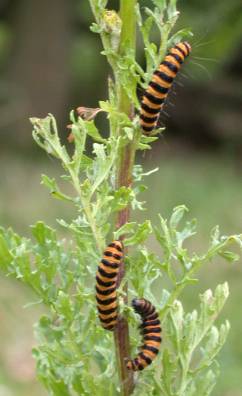
Ragwort produces alkaloid toxins which cause neurological and liver damage, blindness, paralysis and death in livestock (especially horses and to a lesser extent cattle). However, when alive it is unpalatable and animals usually avoid it unless they are starving. It is dangerous mainly when cut and dried in hay, when it loses its bitter taste and is more likely to be eaten. This is why ragwort was one of the five plants listed as "injurious" in the Weeds Act 1959, which required landowners to prevent it spreading. That Act has been updated by the Ragwort Control Act 2004, under which Defra has produced a code of practice for ragwort control.
Ragwort is a biennial with a high production of wind-blown seeds, and a very successful colonist of bare ground. On the commons we have large areas of bare soils including where the runways and roads have been removed, and the bioremediation areas (where soil contaminated by aviation fuel is being "aired" to allow bacteria to break down the pollutants). WBC attempt to control it by spraying (but there's a limit to what can be sprayed in SSSI areas) and by mowing it before its sets seed. Cutting ragwort down doesn't kill it - in fact it provokes the plant into becoming a perennial, but at least it stops the current year's seeds. The best method of control is to dig or pull it out by the roots - which the GCCV do on one or two tasks each summer. It always seems to be a really hot day, and it's hard work, so we reward ourselves with an evening barbecue after the June or July task.
However, this is a native species, a legitimate part of the ecosystem and one of our most valuable plants for wildlife. It is colonised by 14 fungi, its leaves and stems feed at least 77 insects and its nectar at least 177. These include five "red data book" species and eight classified as "nationally scarce". Some are generalists, but at least 30 invertebrate species depend totally on ragwort (including the caterpillars of the cinnabar moth, pictured here). Even if it were possible (dream on!) to eradicate ragwort from the commons, we would not want to do so. We just want to keep it down to a level which doesn't pose a threat to the cattle.
Construction and crafts
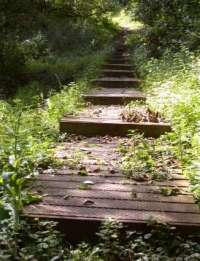

Not all the tasks are about ripping stuff out - sometimes we put stuff in! We have made, installed or otherwise done...
- Footpath surfacing and edging boards
- Waymark posts and other signage
- Bridge-building
- Dragon's teeth to prevent vehicles getting onto the common
- Boardwalks and steps
- A bat hibernaculum (converted from one of the old airbase buildings)
- Bird and bat boxes
- Besom brooms (using traditional techniques, and materials sourced from the commons)
- Hedge laying
- Fence and gate repairs
- Filling potholes in the gravel car parks
Miscellaneous tasks
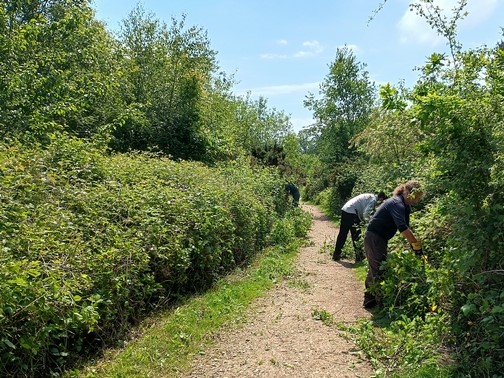
- Vegetation clearance alongside footpaths to keep them passable
- Tree planting (for example we've planted trees and shrubs around the main car park, and to block out lighting from a hospital which adjoins part of the site)
- Pond clearance
- Collecting broom seed to raise locally-sourced plants for screening
- Nightjar surveys
- Removing old fencing materials and other seriously big rubbish left over from airbase days
- Scraping off bracken litter to expose the soil and encourage dormant heather seeds to germinate
- Spreading heather clippings to encourage seeding into bare ground